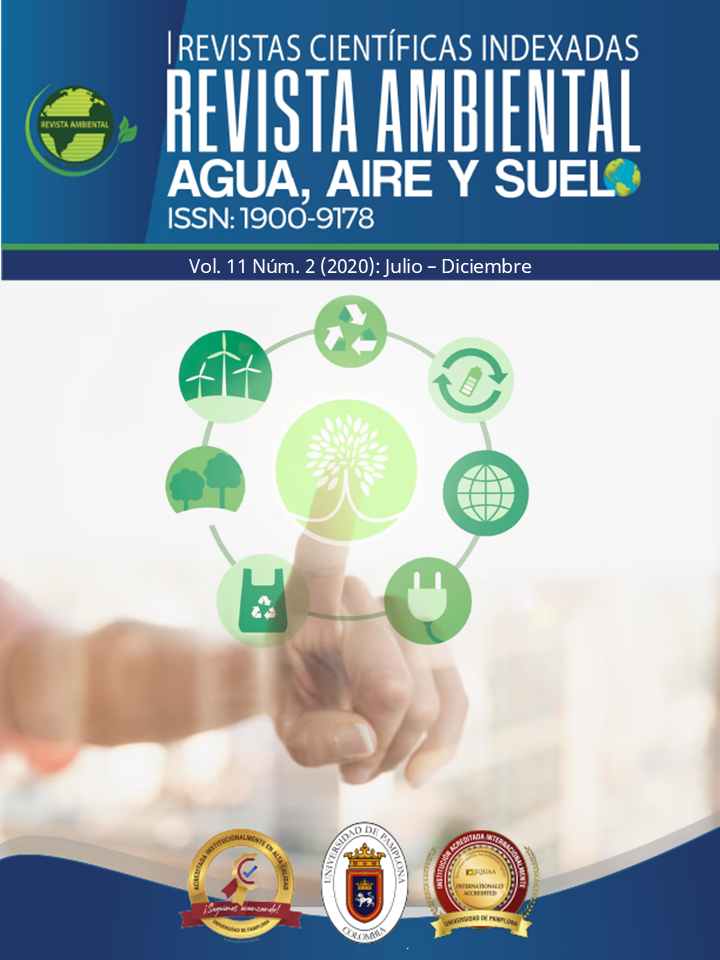Introducción al uso de coagulantes naturales en los procesos de potabilización del agua
DOI:
https://doi.org/10.24054/aaas.v11i2.873Palabras clave:
Agua potable, gestión de recursos hídricos, procesos químicosResumen
El acceso al recurso hídrico es una de las necesidades básicas para la supervivencia de los seres humanos y animales, por ende, es necesario buscar estrategias y procesos que mejoren la calidad del agua potable, basada en procesos sustentables, amigables con el medio ambiente y seguro para el consumo humano. Por tanto, el presente artículo realiza una revisión detallada del uso de coagulantes naturales en el tratamiento de agua potable con el propósito de reemplazar los coagulantes químicos, mediante el uso de base de datos académicas y científicas, se encuentra que los aglomerantes son a base de bacterias, animales y plantas como la Opuntia Ficus Indica, y entre otros coagulantes que son viables para presentarse como alternativas naturales en el proceso de coagulación para la potabilización del recurso hídrico.
Descargas
Referencias
Abu Hasan, H., Muhammad, M. H., & Ismail, N. ’Izzati. (2020). A review of biological drinking water treatment technologies for contaminants removal from polluted water resources. Journal of Water Process Engineering, 33, 101035. https://doi.org/10.1016/j.jwpe.2019.101035
Ahmadi, N., Chaibakhsh, N., & Zanjanchi, M. A. (2016). Use of Descurainia sophia L. as a natural coagulant for the treatment of dye-containing wastewater. Environmental Progress & Sustainable Energy, 35(4), 996-1001. https://doi.org/10.1002/ep.12311
Ang, W. L., & Mohammad, A. W. (2019). Integrated and hybrid process technology. En Sustainable Water and Wastewater Processing (pp. 279-328). Elsevier. https://doi.org/10.1016/B978-0-12-816170-8.00009-0
Ang, W. L., & Mohammad, A. W. (2020). State of the art and sustainability of natural coagulants in water and wastewater treatment. Journal of Cleaner Production, 121267. https://doi.org/10.1016/j.jclepro.2020.121267
Asrafuzzaman, Md., Fakhruddin, A. N. M., & Hossain, Md. A. (2011). Reduction of turbidity of water using locally available natural coagulants. ISRN Microbiology, 2011, 1-6. https://doi.org/10.5402/2011/632189
Bolto, B., & Gregory, J. (2007). Organic polyelectrolytes in water treatment. Water Research, 41(11), 2301-2324. https://doi.org/10.1016/j.watres.2007.03.012
Choy, S. Y., Prasad, K. M. N., Wu, T. Y., & Ramanan, R. N. (2015). A review on common vegetables and legumes as promising plant-based natural coagulants in water clarification. International Journal of Environmental Science and Technology, 12(1), 367-390. https://doi.org/10.1007/s13762-013-0446-2
Choy, S. Y., Prasad, K. N., Wu, T. Y., Raghunandan, M. E., & Ramanan, R. N. (2014). Utilization of plant-based natural coagulants as future alternatives towards sustainable water clarification. Journal of Environmental Sciences, 26(11), 2178-2189. https://doi.org/10.1016/j.jes.2014.09.024
Choy, S. Y., Prasad, K. N., Wu, T. Y., Raghunandan, M. E., & Ramanan, R. N. (2016). Performance of conventional starches as natural coagulants for turbidity removal. Ecological Engineering, 94, 352-364. https://doi.org/10.1016/j.ecoleng.2016.05.082
Damkjaer, S., & Taylor, R. (2017). The measurement of water scarcity: Defining a meaningful indicator. Ambio, 46(5), 513-531. https://doi.org/10.1007/s13280-017-0912-z
Durai, R., Rajalakshmi, G., Joseph, J., Kanchalochana, S., & Hari, V. (2012). Tamarind seed polysaccharide: A promising natural excipient for pharmaceuticals. International Journal of Green Pharmacy, 6(4), 270. https://doi.org/10.4103/0973-8258.108205
Fawell, J., & Nieuwenhuijsen, M. J. (2003). Contaminants in drinking water. British Medical Bulletin, 68(1), 199-208. https://doi.org/10.1093/bmb/ldg027
Food and Agriculture Organization of the United Nations. (2013). Afrontar la escasez de agua: Un marco de acción para la agricultura y la seguridad alimentaria. http://public.ebookcentral.proquest.com/choice/publicfullrecord.aspx?p=3239163
Freitas, T. K. F. S., Almeida, C. A., Manholer, D. D., Geraldino, H. C. L., de Souza, M. T. F., & Garcia, J. C. (2018). Review of utilization plant-based coagulants as alternatives to textile wastewater treatment. En S. S. Muthu (Ed.), Detox Fashion (pp. 27-79). Springer Singapore. https://doi.org/10.1007/978-981-10-4780-0_2
Gerba, C. P. (2009). Drinking water treatment. En Environmental Microbiology (pp. 531-538). Elsevier. https://doi.org/10.1016/B978-0-12-370519-8.00025-0
Gerba, C. P., & Pepper, I. L. (2019). Drinking water treatment. En Environmental and Pollution Science (pp. 435-454). Elsevier. https://doi.org/10.1016/B978-0-12-814719-1.00024-0
Graham, N., Gang, F., Fowler, G., & Watts, M. (2008). Characterisation and coagulation performance of a tannin-based cationic polymer: A preliminary assessment. Colloids and Surfaces A: Physicochemical and Engineering Aspects, 327(1-3), 9-16. https://doi.org/10.1016/j.colsurfa.2008.05.045
Hoa, N. T., & Hue, C. T. (2018). Enhanced water treatment by Moringa oleifera seeds extract as the bio-coagulant: Role of the extraction method. Journal of Water Supply: Research and Technology-Aqua. https://doi.org/10.2166/aqua.2018.070
Hoslett, J., Massara, T. M., Malamis, S., Ahmad, D., van den Boogaert, I., Katsou, E., Ahmad, B., Ghazal, H., Simons, S., Wrobel, L., & Jouhara, H. (2018). Surface water filtration using granular media and membranes: A review. Science of The Total Environment, 639, 1268-1282. https://doi.org/10.1016/j.scitotenv.2018.05.247
Jiang, J.-Q. (2015). The role of coagulation in water treatment. Current Opinion in Chemical Engineering, 8, 36-44. https://doi.org/10.1016/j.coche.2015.01.008
Descargas
Publicado
Número
Sección
Licencia
Derechos de autor 2021 REVISTA AMBIENTAL AGUA, AIRE Y SUELO

Esta obra está bajo una licencia internacional Creative Commons Atribución-NoComercial 4.0.










